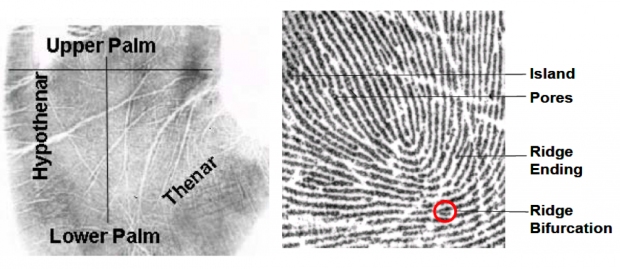A jogger found the bloodstained and filthy body of Kristopher Olinger by the side of the road one September morning in 1997. The last time anyone saw the 17-year-old from Pacific Grove, CA was at midnight, when he went out to photograph the ocean for a school project. The police investigation determined that he had been carjacked, kidnapped, and stabbed. His abductors drove him to a dirt turnout along a deserted coastal road and threw him over a 15-foot cliff into the ocean below. Olinger spent the next hour climbing back up the cliff, only to expire at the top from his multiple knife wounds.
Ten days later Olinger’s car was found abandoned in a San Jose neighborhood, but fingerprints on the car didn’t yield any hits. The investigation turned up one false lead after another and finally went cold. In 2004, then-Gov. Arnold Schwarzenegger offered a $50,000 reward. That same year, California opened its palm print database and a print taken from the stolen car finally had a match.
Though not as common or straight forward as fingerprinting, palm print identification has become an important tool in identifying criminal suspects. Law enforcement agencies estimate that about one-third of crime scene prints are from palms. They can be especially useful in thefts and carjackings because while most criminals are careful about not leaving fingerprints, few are aware that their palm prints are just as incriminating.
“It is as accurate as fingerprint matching,” says Soweon Yoon, a graduate student who researches biometric detection systems at Michigan State University. The ridges and lines in the palm are a set of unique biometric identifiers, just like in a set of fingerprints. But matching two palm prints is a complicated process. Finger ridges have very recognizable arches, whorls and loops, but matching a palm print bears a surprising resemblance to palm reading.
A print analyst must first determine which part of the hand the print came from and then look for a variety of lines, wrinkles, “cat scratches,” ridges and sweat pores. And since palms are so much bigger than fingers, palm prints have on average, 1,000 identifying characteristics, while the average finger print has just 100. Yoon says that the large number of characteristics makes it more difficult to write computer algorithms that will match a suspect’s palm with a print in the database. But they also make palm print matching highly accurate when using good quality prints.
The driver’s side window of Olinger’s car contained a single palm print that Carl Miller, the police chief at the time, referred to as a “beautiful.” The California print database linked it back to a man named Jacobo Ruelas of Soledad, CA. Ruelas was already a known gang member, and his palm print was in the database from a previous arrest on charges of carjacking and robbery in 1998.
Police sent out an arrest warrant for Ruelas, but it took a SWAT team to finally apprehend him after a three-hour manhunt. His lawyer claimed that he had planned to turn himself in, but had not yet put his personal affairs in order. A few days later police officers arrested Jacobo’s brother, Angel, with much less fanfare. Fingerprints and DNA found inside Olinger’s car placed him at the scene.
The fact that Jacobo Ruelas’ palm print was present in the database was a great stroke of luck for the case. Palm print databases are considerably smaller than the ones for fingerprints. Though several state and local police departments started their own palm print databases in the early 2000s the FBI only launched a national palm print system in May, as part of its Integrated Automated Fingerprint Identification System (IAFIS). Investigators frequently collect palm prints from crime scenes and from people arrested for serious crimes, but the practice is not yet routine.
The ability to match a palm print also depends greatly on the quality of the latent print that is lifted from the crime scene. A 2012 study tested one algorithm’s ability to match high quality prints and determined that it produced the right print on the first hit almost 98% of the time. When searching partial prints against the database the accuracy dropped to 92%. The rate in real life is probably much lower due to the poor quality of many latent prints.
Still, fingerprinting has similar problems. A 2011 study by the National Institutes of Standards and Technology that compared the matching accuracy of several commercial algorithms found that results varied greatly, depending on the quality of the print and the algorithm used. Even in the FBI system, a search will bring back several possible prints, but two analysts must independently evaluate the results with their own eyes to determine if any are a true match.
“Latent fingerprinting itself is still very challenging right now,” Yoon says. She sees great potential for using palm prints to solve crimes, but considering the current limitations, she says they are best used in conjunction with other evidence collected from a crime scene.
After the arrest of the Ruelas brothers, Angel pleaded guilty to murder because he wanted to spare Olinger’s family the emotional turmoil of a trial. He is now serving life in prison. Jacobo pleaded innocent, and after several delays, the trial ended on October 2nd, Olinger’s birthday. The jury found Jacobo Ruelas guilty of felony murder, kidnapping and carjacking, in the Salinas, CA courthouse. He will serve life in prison with no possibility of parole.
Without that palm print, the Olinger murder case might have remained unsolved. Unfortunately, the decision came back too late for Olinger’s parents, who passed away in 2003. But the verdict brings an end to the waiting and uncertainty for Olinger’s younger brother. He and his new wife are finally planning a long-delayed honeymoon.
